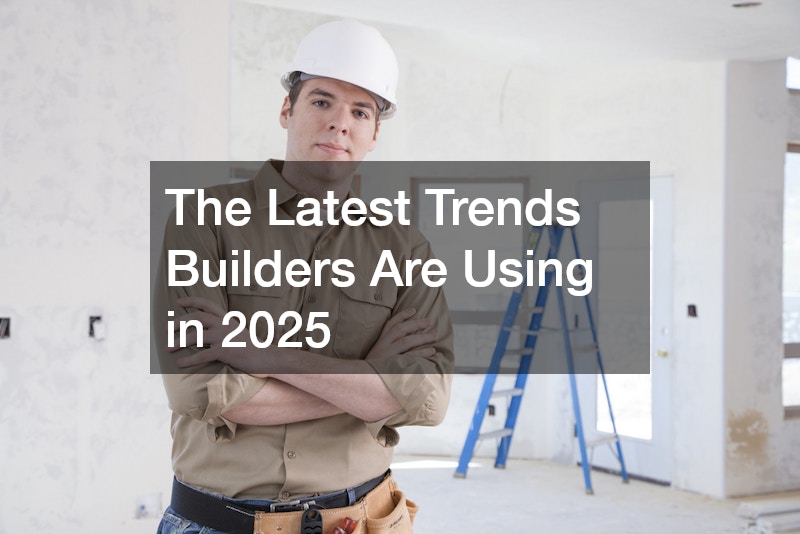The Latest Trends Builders Are Using in 2025
In 2025, builders across Australia are embracing innovative trends that reshape the way homes and commercial projects are designed and constructed. As technology advances and sustainability becomes a priority, the construction industry is evolving to meet new demands for efficiency, environmental responsibility and style.
Staying informed about these trends helps homeowners, developers and industry professionals make smart choices and stay competitive.
This article explores some of the latest trends builders are using in 2025 to deliver better, greener and smarter buildings.
Sustainable Building Materials
Builders are increasingly choosing sustainable materials that reduce environmental impact without compromising quality. Recycled steel, timber from certified forests and low-VOC paints are popular options. These materials not only help conserve natural resources but also improve indoor air quality and reduce waste sent to landfill.
There is a growing emphasis on using products with environmental certifications to meet green building standards. Builders are also exploring innovative options like hempcrete, bamboo and rammed earth, which offer durability and natural insulation.
Energy Efficiency and Smart Homes
Energy efficiency is front of mind for many builders and their clients in 2025. Solar panels and battery storage systems are commonly integrated into new homes to reduce reliance on the grid. Builders also focus on airtight construction, superior insulation and energy-efficient windows to minimise heating and cooling needs.
Smart home technology is another major trend. Builders are incorporating automation systems that control lighting, temperature, security and appliances. These systems enhance comfort, convenience and energy savings, appealing to tech-savvy homeowners.
Modular and Prefabricated Construction
Modular and prefabricated building methods continue to gain traction among builders. These approaches involve manufacturing sections of a building off-site under controlled conditions and assembling them quickly onsite.
This method reduces construction time, waste and labour costs while maintaining high quality. It is especially popular for multi-unit developments and affordable housing projects. Advances in design flexibility allow builders to create customised, architecturally interesting homes using modular techniques.
Water Conservation Features
With water scarcity becoming an increasing concern, builders are installing systems that reduce water usage and promote reuse. Rainwater tanks, greywater recycling and drought-tolerant landscaping are integrated into many new builds.
Low-flow fixtures and smart irrigation systems help homeowners conserve water without sacrificing convenience. Builders often advise clients on how to maximise water efficiency as part of sustainable living goals.
Enhanced Safety and Compliance
Builders are adopting the latest safety protocols and technologies to protect workers and meet stringent regulatory standards. Wearable tech that monitors worker health and site conditions is becoming more common, along with advanced scaffolding and machinery.
Compliance with updated Australian building codes also drives innovations in fire safety, structural engineering and accessibility features. Builders who prioritise safety not only protect their teams but also deliver higher-quality outcomes for clients.
Focus on Indoor-Outdoor Living
Design trends favour seamless connections between indoor and outdoor spaces. Builders incorporate large sliding or folding doors, outdoor kitchens and covered patios to enhance lifestyle and entertaining options.
This approach maximises natural light and ventilation, reduces energy costs and makes homes feel more spacious. Outdoor living areas are designed to be functional year-round, reflecting Australia’s climate and lifestyle preferences.
Use of Sustainable Energy Sources
Beyond solar, builders are exploring alternative energy solutions such as heat pumps, geothermal systems and small-scale wind turbines. These technologies offer efficient heating, cooling and power generation, supporting net-zero energy homes.
Builders are also advising clients on government rebates and incentives available for renewable energy installations, making sustainable choices more accessible.
Integration of Advanced Building Software
Technology is transforming the way builders plan and manage projects. Building Information Modelling (BIM) software allows for detailed 3D visualisations, clash detection and efficient collaboration between architects, engineers and trades.
This digital approach reduces errors, speeds up approvals and improves project transparency. Builders using advanced software tools can deliver more accurate timelines and budgets.
Emphasis on Customisation and Personalisation
Modern homeowners want homes that reflect their tastes and lifestyles. Builders are responding with flexible floor plans, bespoke finishes and smart storage solutions.
From eco-friendly features to multi-generational living spaces, builders offer customised options to meet diverse needs. This personalised approach increases client satisfaction and property value.
In 2025, builders in Australia are embracing sustainability, technology and customer-focused design like never before. From eco-friendly materials and energy-saving systems to modular construction and smart homes, these trends are transforming the industry.
Staying informed about these innovations allows homeowners and developers to make better decisions and benefit from the latest advances. Whether building a new home or renovating, working with builders who understand these trends ensures a future-proof investment that’s efficient, comfortable and environmentally responsible.

